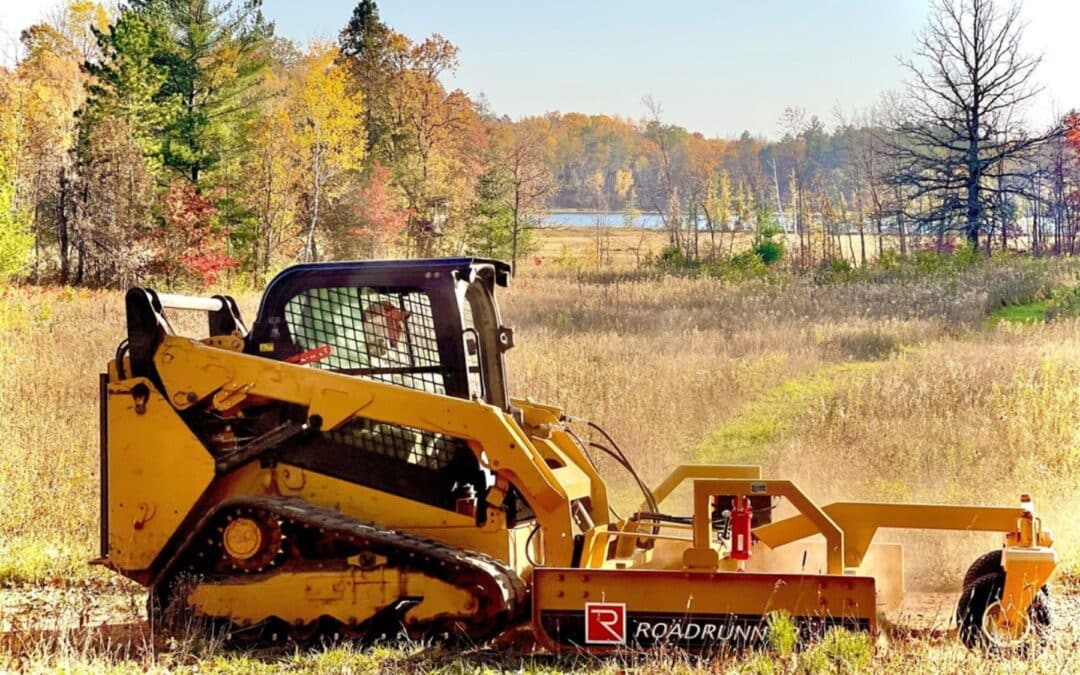There’s so much you can accomplish with your skid steer and bucket combo. Until…you run into a job where you need to move a big pile of cut tree branches and long logs.
All of a sudden, your regular bucket doesn’t cut it anymore. Trying to scoop those loose, springy branches with your bucket feels like trying to play pick-up sticks with a big, clumsy mitten on your hand. Your skid steer bucket simply wasn’t made for this job.
You need a different skid steer attachment–a skid steer grapple would make the job easy. But a regular bucket is clumsy and frustrating.
The beauty of a skid steer is its flexibility. But only if you’ve got the tools to match the job.
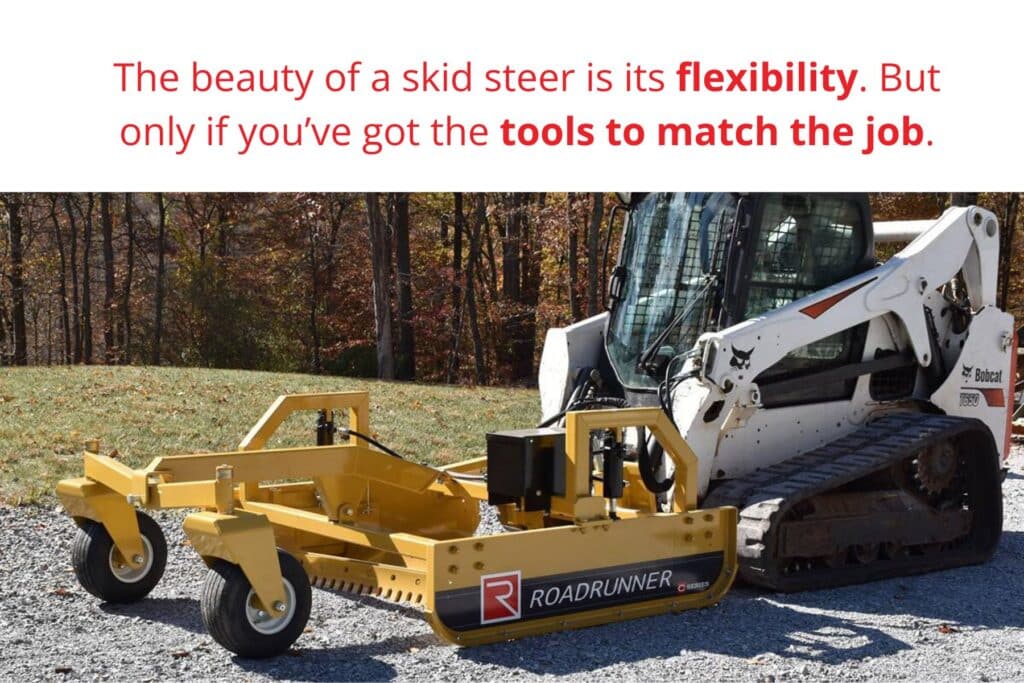
At Roadrunner Equipment, we’ve been working with skid steers and attachments for years. This guide is here to cut through the confusion. Whether you’re new to skid steer attachments or looking to expand your fleet, we’ll walk you through the most common attachment types, how to choose the right ones, and how to keep them running safely.
Let’s dig in.
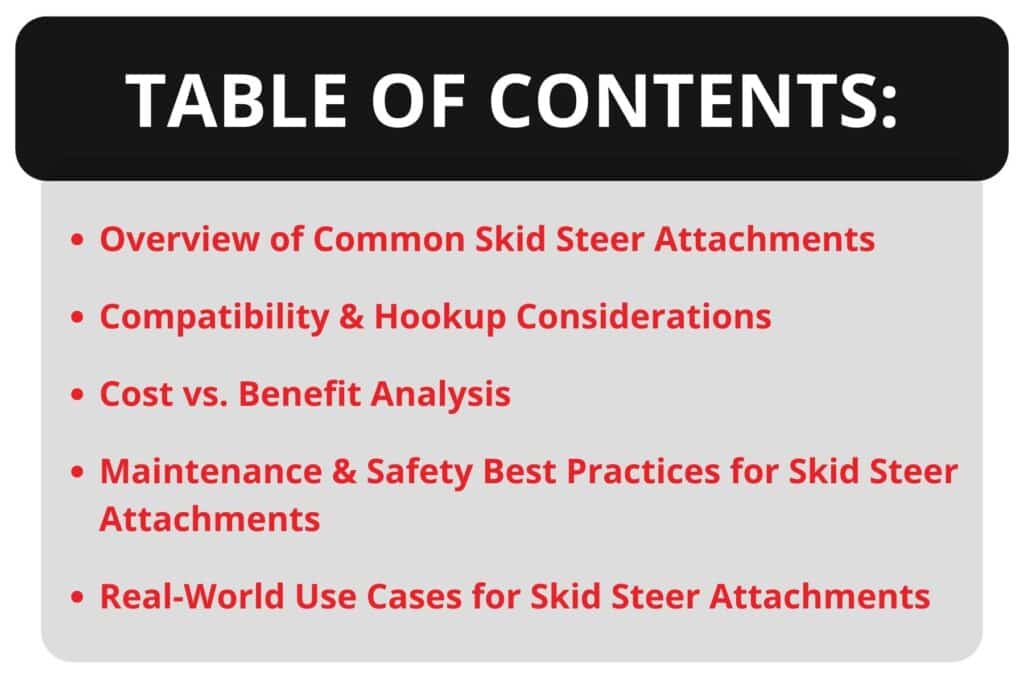
Overview of Common Skid Steer Attachments
Skid steer attachments turn your skid steer into a Swiss Army knife on wheels. Whether you’re digging, lifting, cutting, or pushing, there’s an attachment built to do the job faster, safer, and with less back pain.
Here’s a quick look at the heavy hitters most equipment owners and contractors rely on:
Buckets
Buckets are the OG of skid steer attachments. From moving dirt to hauling gravel, general-purpose buckets are great for everyday jobs.
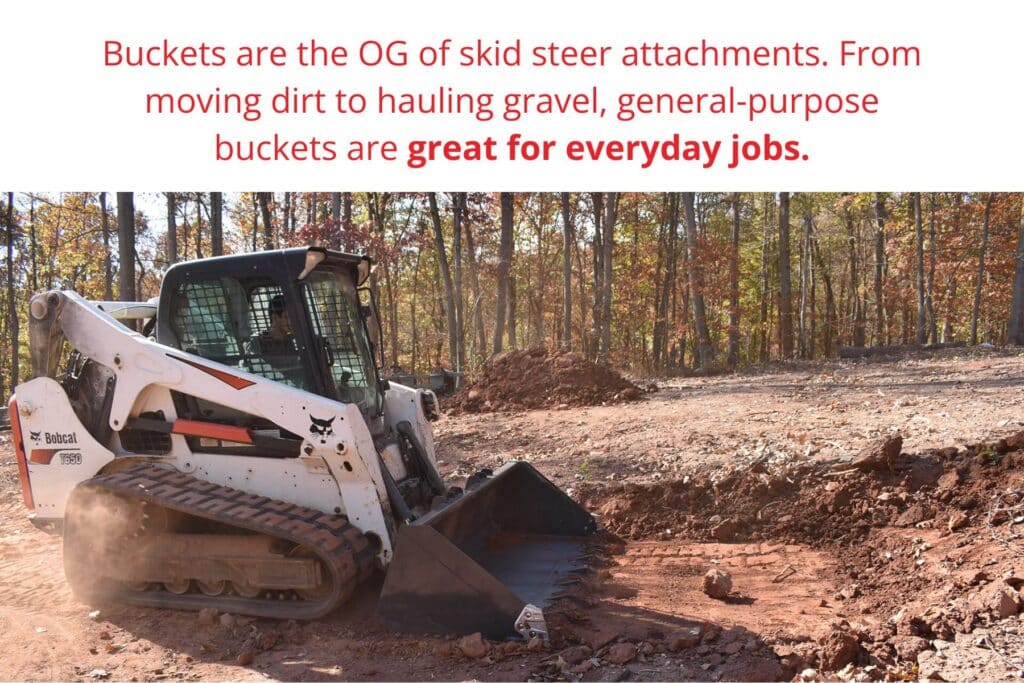
However, there are also specialty buckets, such as rock buckets, 4-in-1 combo buckets, and stump buckets, each designed for specific tasks.
Augers
Need to dig holes fast? Augers to the rescue! Think fence posts, tree planting, or foundation footings. Instead of renting a post-hole digger or working by hand, an auger attachment chews through soil, clay, and even some rock with ease.
Pallet Forks
Forks turn your skid steer into a forklift, perfect for moving pallets, lumber, or heavy materials around a job site. For contractors, landscapers, or even farmers, pallet forks add instant versatility.
Grapples
When it’s time to grab and haul debris, logs, or brush, grapples shine. They clamp down hard, making cleanup jobs quicker and safer. There are root grapples, brush grapples, and industrial grapples—each with different claw configurations for the task at hand.
Trenchers
Running irrigation, plumbing, or electrical lines? Trenchers dig clean, consistent trenches without tearing up your whole site. No need to bring in an excavator or rent extra equipment.
Brush Cutters
Brush cutters are like mowers on steroids. They’ll cut through grass, brush, and more. Whether you’re clearing a field or cleaning up roadside overgrowth, this attachment saves hours of work.
Whether you’re digging in or clearing out, these attachments pull their weight.
Compatibility & Hookup Considerations
Skid steer attachments aren’t one-size-fits-all. And finding out something doesn’t fit after delivery? That’s a headache you don’t need.
Before buying or renting any attachment, you need to consider a few key factors. Because even the best attachment is useless if your skid steer can’t run it.
Let’s break it down:
Universal Mount vs. Machine-Specific
Most modern skid steers use the universal quick-attach system, often called the “Bob-Tach” or standard SSL mount. It’s a plate-style hookup designed to fit attachments from different manufacturers.
That means you can buy a grapple from Brand A and run it on a skid steer from Brand B. Handy, right?
However, some older machines or compact track loaders may use proprietary systems. Always check your machine’s mount style before investing in attachments.
Hydraulic Flow Rates Matter
Many attachments, especially powered ones like augers, trenchers, or brush cutters, rely on your machine’s hydraulic system. The catch? Not every skid steer puts out the same flow.
There are two basic types:
- Standard flow (12–25 GPM) – Common in most machines. Suitable for general-purpose attachments.
- High-flow (26+ GPM) – Needed for more demanding tools like cold planers, forestry mulchers, or heavy-duty brush cutters.
Using a high-flow attachment on a standard-flow machine will cause it to underperform. Worse, it could overheat or damage your system.
Before buying, check the hydraulic specifications. Then, match it to the attachment’s requirement.
Cost vs. Benefit Analysis
Let’s be honest: attachments aren’t cheap. But they’re also not just a cost—they’re an investment.
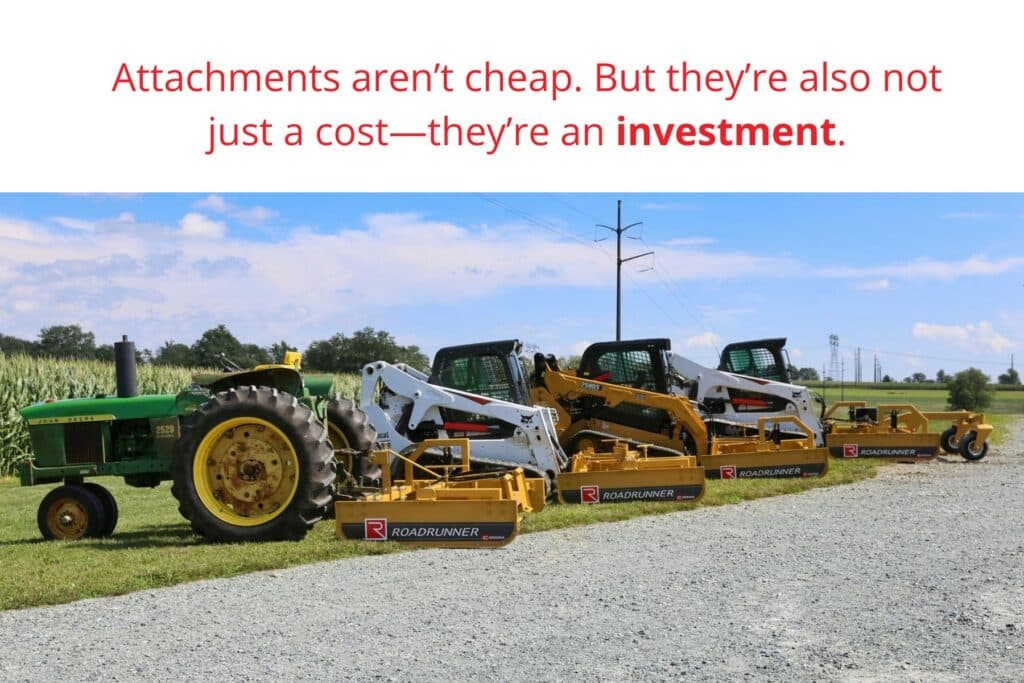
The challenge is knowing when that investment makes sense.
Here’s how to think through the numbers before you swipe your card or sign a rental agreement.
The Purchase Price: Upfront but Long-Term
Buying an attachment outright usually makes sense if:
- You’ll use it regularly.
- You want complete control over maintenance and usage.
- You can spread the cost over years of use.
For example, if you’re clearing brush every week, a quality brush cutter pays for itself quickly. But if you only need it once every few months, not so much.
Prices vary widely, but here is what you might expect in the South/Central PA region:
- Basic bucket or pallet fork: $800–$2,000
- Auger or grapple: $2,500–$5,000
- Trencher, snow blower, forestry mulcher: $5,000–$20,000+
And don’t forget: better-built tools from reliable brands cost more but usually last longer and perform better.
Renting Attachments: When It Makes More Sense
Sometimes, renting is the smart move.
Say you’ve got one trenching job coming up. You don’t want to drop $8,000 on a trencher you won’t touch again this year. That’s where short-term rental saves your budget.
Also, if you rent an attachment, you won’t have to maintain it or store it.
Rental rates vary by region, but here’s a ballpark for what rates are like in South/Central PA:
- Pallet fork: $30–$40/day
- Auger or trencher: $65–$125/day
- Brush cutter or snow blower: $200–$400/day
Run the numbers. If you’d need to rent something more than 5–6 times a year, buying may be the better call.
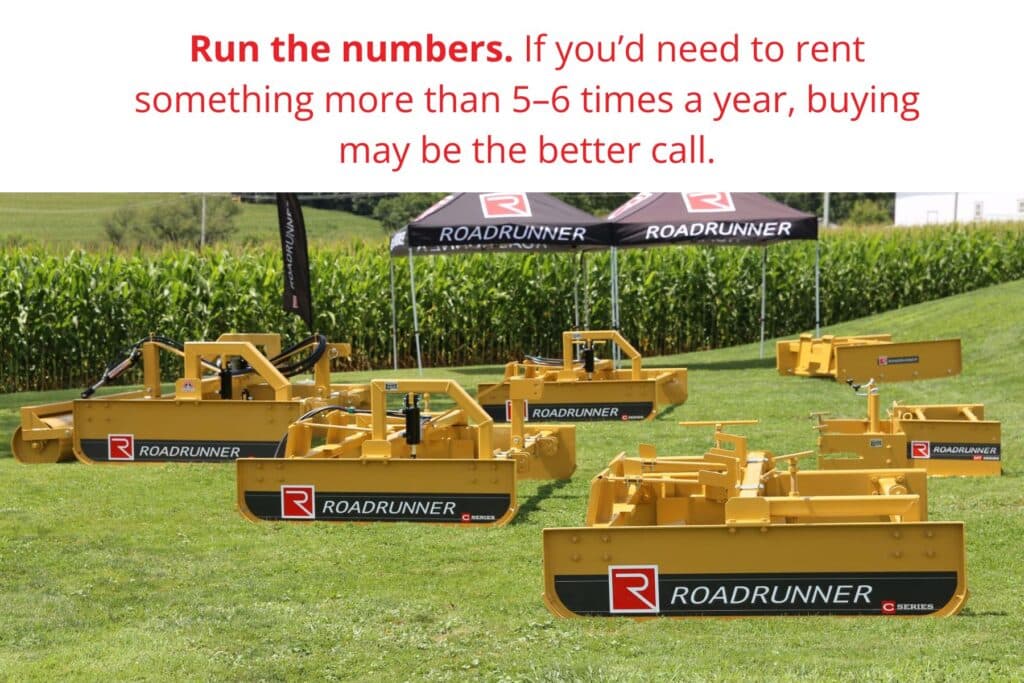
The ROI Equation
The real question isn’t “What does it cost?” It’s “What will it do for me?”
If a $3,000 grapple attachment helps you load and unload twice as fast, you’re saving labor, saving time, and winning more jobs.
Attachments that increase speed, safety, or your ability to offer more services often pay off quicker than expected.
Ask yourself:
- Will this attachment let me take on more projects?
- Will it save me labor or reduce job time?
- Will it protect my team from injury or strain?
If the answer is yes, the investment could easily pay for itself.
Maintenance & Safety Best Practices for Skid Steer Attachments
Using skid steer attachments well means more than just buying the right tool. You’ve got to keep them in good shape—and keep yourself safe. Let’s dive into what that looks like.
1. Inspection Routines
Before every job, give your attachments a quick once-over. Check for cracks, dents, or worn parts. Look at:
- Hydraulic hoses and fittings for leaks or damage
- Pins and bushings for excessive wear
- Cutting edges or teeth for dullness or breaks
A small problem now can become a big headache later.
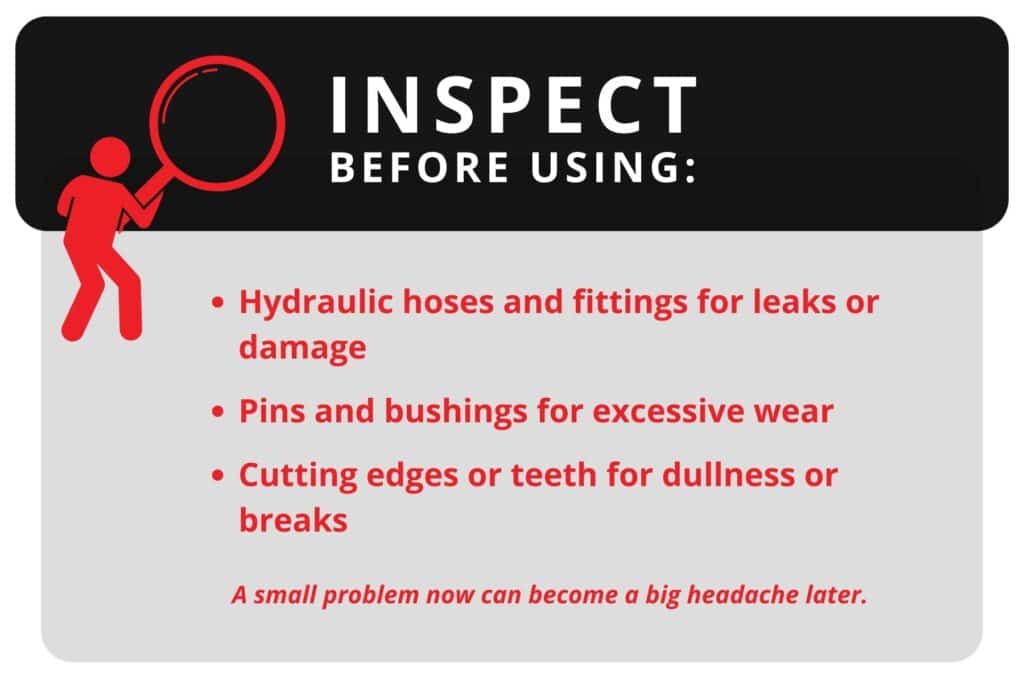
2. Lubrication Points
Attachments need regular grease. Look for grease fittings on pivot points, bearings, and pins. Skipping this? Expect faster wear and possible failure. Your skid steer’s manual or the attachment’s guide will show you exactly where to grease.
3. Operator Training
A great attachment can’t do its job if the operator isn’t trained. Make sure everyone using the skid steer knows how to:
- Safely connect and disconnect attachments
- Understand the machine’s hydraulic flow limits
- Handle the attachment properly during the operation
Mistakes here can cause accidents or damage equipment.
4. Safe Change-Out Procedures
Switching attachments is common—just don’t rush it. Follow these steps:
- Park on a level surface with the engine off
- Lower the attachment to the ground
- Relieve hydraulic pressure before disconnecting hoses
- Use locking pins or latches as intended
Doing this right means no surprises, no injuries, and no costly damage.
Real-World Use Cases for Skid Steer Attachments
There are buckets of potential for skid setter attachments in real-world job sites every day. Whether you’re moving dirt, clearing brush, or breaking concrete, the right attachment turns your skid steer into a job site MVP.
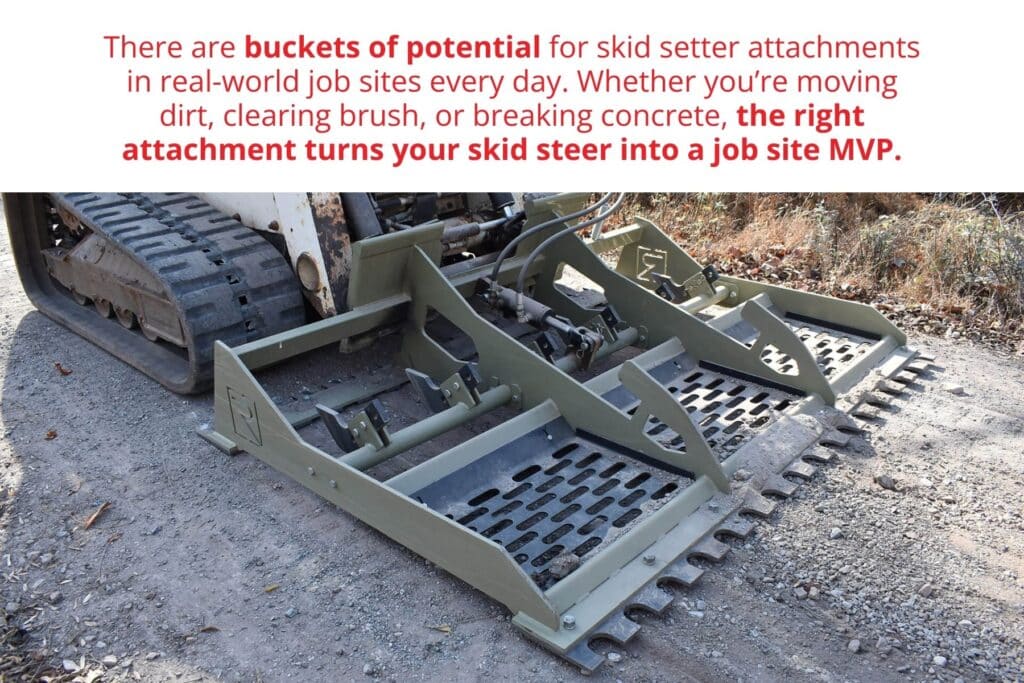
Here’s how contractors and operators are putting these tools to work.
Landscaping
- Buckets for grading, hauling soil, and leveling gravel
- Grapples for removing brush, logs, and stumps
- Augers for digging post holes for fences or deck footers
- Pallet forks for moving pallets of mulch, stone, or pavers
Construction
- Trenchers for utility line installation
- Breakers for tearing up concrete or blacktop
- Buckets for backfilling and site cleanup
- Hydraulic compactors for preparing solid ground
Agriculture
- Manure buckets and silage defacers help with daily chores
- Augers make quick work of fencing projects
- Bale spears move hay efficiently
- Snow blades or blowers keep driveways clear all winter
Snow Removal
- Snow pushers move volume fast in parking lots
- Snow blowers cut clean paths along sidewalks or driveways
- Angled blades handle plow work with precision
Demolition
- Hydraulic breakers knock down concrete walls
- Grapples grab debris and load dumpsters
- 4-in-1 buckets scoop, push, and clamp heavy loads
Wrapping It Up
Skid steer attachments aren’t just add-ons. They’re force multipliers.
Whether you’re landscaping a backyard or clearing snow, the right tool can save time, reduce labor, and get the job done right.
The key is choosing attachments that fit your needs, your machine, and your budget.
At Roadrunner Equipment, we understand how much your work depends on reliable tools. That’s why we’re here to help you make smart, durable choices—whether you’re digging, lifting, grading, or clearing.
We offer a variety of skid steer attachments and other equipment for your business’s needs:
Need help choosing the right attachment? Contact Roadrunner Equipment today. We’re ready when you are. VIEW OUR ATTACHMENTS

